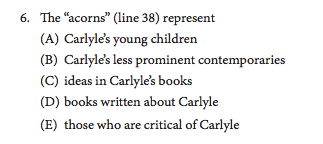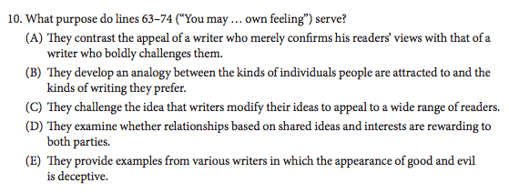AP LANG MC
0 General Document comments
0 Sentence and Paragraph comments
0 Image and Video comments
The Multiple-Choice Section: An Overview
Section I of the AP English Language and Composition test is the multiple-choice section. This section will have 45 questions testing you on how well you can read and understand nonfiction passages for their use of rhetoric.
These questions are divided into two categories: Reading questions and Writing questions. According to the College Board, you'll see 23–25 Reading questions and 20–22 Writing questions on the multiple choice section of the exam.


On the exam, the questions will be presented in five sets, and each set will be attached to what's called a "stimulus passage." You will receive a bit of orienting information at the beginning of this passage, for example "this essay originally appeared in a major national newspaper in the 1980s." Each passage will have about 7-10 questions associated with it.


The College Board tests eight core skills on the AP Language exam. Here are the skills you'll need to know along with what percentage of the exam covers each skill:
| Skill Category | Exam Weighting (%) |
| Rhetorical Situation—Reading | 11-14% |
| Rhetorical Situation—Writing | 11-14% |
| Claims and Evidence—Reading | 13-16% |
| Claims and Evidence—Writing | 11-14% |
| Reasoning and Organization—Reading | 13-16% |
| Reasoning and Organization—Writing | 11-14% |
| Style—Reading | 11-14% |
| Style—Writing | 11-14% |
The AP Language multiple choice section is worth 45% of your total exam score. You will receive one point to your raw score for every question you answer correctly. However, as on other AP exams, your raw score will be converted to a scaled score from 1-5.





Be very careful on multiple choice because it can mess you up.

This is bold to draw attention that even though it’s multiple choice, it’s worth 45% of the grade.

This is worth a lot so it’s important to practice these skills so you can make a good grade on the exam
But what's actually on the multiple-choice section? The next section explores what kinds of questions you can expect to actually be asked on the exam.
The 8 Types of Multiple-Choice Questions
There are eight kinds of multiple choice questions on the AP Language exam. In this section, I'll go over each type, provide an example question, and walk you through answering it. All of the example questions come from the "Course and Exam Description." You can find the original passages these questions are referring to there as well.


Type 1: Reading Comprehension
As you might expect, reading comprehension questions are about testing if you understood the passage on a concrete level: what does this particular sentence mean in a literal sense You can usually identify them from phrases like "according to" and "refers."
To succeed on these kinds of questions, your best strategy is to go back and re-read the part of the passage the question is asking about. Do so carefully, and when you then answer the question, focus on what the passage is actually saying outright. Don't infer on reading comprehension questions!


Example:

Let's go back and look at Lines 23-26 to answer this question: "But 'books are not about schedules,' author Stephanie Nolen argues; rather, they are 'about submerging yourself...about getting consumed.'"
To return to the question, what is her "primary criticism of book clubs," then? Well, she says, "books are not about schedules." So, they shouldn't have to be a scheduled-in obligation. The only answer that choice that resembles what she actually says in the passage is that the problem with books clubs is that they (A), "are too programmed."
Type 2: Implication
This question style moves beyond basic, concrete reading comprehension into the realm of implication. Implication is what the author seems to say without actually coming out and saying it directly. However, even though the answer may not be written out clearly in the passage, the question will still have a clear correct answer based on textual evidence. You can identify implication questions from phrases like "best supported," "implies," "suggests," and "inferred."
As for reading comprehension questions (and indeed, all multiple-choice questions on the AP) turn and look back at the relevant part of the passage before you answer. Then ask yourself: Which interpretation put forth by the answer choices does the passage *most* support?


Example:

First, we need to find where in the passage names for hurricanes and tornadoes are discussed. We can find this in lines 14-17: "A tornado, although more violent than a much longer lasting hurricane, has a life measured in minutes, and weathercasters watch it snuff out as it was born: unnamed."
What answers about why tornadoes are unnamed and hurricanes are named are at all supported by this line?
Choice (A), "there are too many of them," is clearly incorrect as the line says nothing about the frequency of either weather event.
Choice (B) says, "their destruction is not as great as that of hurricanes." This is a trap! You may know based on your own knowledge that hurricanes generally incur much greater damages overall than tornadoes, but the passage doesn't say that. You have to choose an implication that is actually supported by the passage, and the passage doesn't say which causes more destruction.
Choice (C) says "they last too short of a time." The passage does say that hurricanes are "much longer lasting" and that the life of a tornado is "measured in minutes." This could be a reasonable answer, but let's make sure it's the best one before we select it.
Choice (D) says "they move too erratically to be plotted" and Choice (E) says tornadoes "can appear in any area of the world." It doesn't matter if either of those statements is true since the question asks what the passage implies, and the passage does not discuss either their movements or where they appear. Thus, (C) is the answer most supported by the passage.

It's a trap! Don't be fooled.
Type 3: Overall Passage and Author Questions
Overall passage and author questions want you to identify key, overarching elements of the passage or author's views, like the purpose of the text, the author's audience, the author's attitude toward the subject, and so on. These questions are identifiable because they won't refer back to a specific place in the text but will instead ask general questions that apply to the entire excerpt.
These questions can be a little more difficult to answer than those where you can look to a specific place in the text to answer your questions. You'll really need to have an overall impression of the passage based on its overarching details.It might be helpful to jot down a couple overall impressions of the excerpt right after you read it, to refer back to when faced with overall passage questions.
Example:



This passage is about the rise of book clubs. The first paragraph gives examples to demonstrate that book clubs have become a popular phenomenon. The second discusses book club backlash and some book club guides. The third paragraph asserts that book clubs are positive and sharing literary experiences is a good thing.
Which of the answers fits with the passage? Answer (A) can be eliminated right away because there is no personal narrative.
Answer (B) can also be eliminated because the passage begins with an example about Oprah, not any "empirical" (numbers-based) data.
Answer (C) can be eliminated because the passage never introduces any questions related to the practice of book clubs.
Choice (D) could be good—the first two paragraphs give mostly description, and the third and final paragraph gives an evaluation.
Choice (E) doesn't fit because there is no initial condemnation of "the practice" (i.e. of book clubs). So (D) is the correct answer.
Type 4: Relationships Between Parts of the Text
Another question type will require you to identify or describe a relationship between two specific parts of the text. This could be paragraphs or shorter line segments, or a specific part of the passage compared to the rest of the passage or the passage as a whole.
My advice for answering these questions is similar to my advice for most questions—go back and read the parts of the passage in question!
You may want to jot down an overarching impression of what each part of the text is accomplishing or saying as you do, which should help you compare them and identify the relationship.
Example:

Because this passage is only two paragraphs long, this question is essentially asking us about the relationship between the first and second halves of the passage.
What is the main idea of each of the sections? Well, the first paragraph describes essentially what makes a strong writer. The second paragraph establishes that Carlyle is "such a writer" and then discusses some of his works and why they are important.
When we look at the answer choices, what matches up best with our main idea descriptions? Clearly (A), which describes how the first paragraph describes the strengths of a writer (which we know Carlyle has based on the topic sentence of the second paragraph), and the second describes Carlyle's "legacy."

What kind of relationship do the parts of the text have?
Type 5: Interpretation of Imagery/Figurative Language
This type of question is concerned with the underlying meaning or implication of imagery or figurative language used in the excerpt. What is the author trying to accomplish with this particular phrase or this metaphor?
Again, it is critical that you go back and read the part of the passage that the question refers to, or you will be completely lost on these questions (more so than on most others). You may want to re-read a few lines before and after as well so you can get a sense of the imagery in context.
Example:

For this to make sense, we need the entire sentence the "acorns" appear in: "It is an idle question to ask if his books will be read a century hence: if they were all burnt as the grandest of Suttees on his funeral pile, it would only be like cutting down an oak after its acorns have sown a forest."
What could this mean? Well, acorns come from oak trees and make more oak trees. So this must refer to something that comes from Carlyle and is somehow a replication of him or his works. The best choices if we think about that, then, would be (A) his children, or (C) the ideas in his books. However, since the passage doesn't mention anything about his children that would be an irrelevant detail and can't be what the acorns represent. So the answer must be (C).
Type 6: Purpose of Part of the Text
These questions will ask you to choose the answer that best states the purpose that a given part of the text serves in the piece. What is the author hoping to accomplish with this specific example/sentence/device? These questions can usually be identified because they will ask specifically about purpose or function of a specific moment.
To address these questions, you will need to, of course, re-read the part of the text in question. Think about what point the author is trying to make in that specific moment, and how that would serve their larger argument.
All parts of a given text will serve the larger argument if they are well-constructed, so if it seems like an interpretation of the text presented in the answer choices doesn't work with the main argument, eliminate it.
Example:

Here are the lines this question is referencing:
"You may meet a man whose wisdom seems unimpeachable, since you find him entirely in agreement with yourself; but this oracular man of unexceptionable opinions has a green eye, a wiry hands, and altogether, a Wesen, or demeanor, that makes the world look blank to you, and whose unexceptionable opinions become a bore; while another man who deals in what you cannot but think 'dangerous paradoxes,' warms your heart by the pressure of his hand, and looks out on the world with so clear and loving an eye, that nature seems to reflect the light of his glance upon your own feeling."
This sentence is really overwhelming, so let's try to break it down and re-write it in a simpler way. Here's how we might summarize it: "You might meet a man who seems wise because he agrees with you, but this man might eventually become a bore; while a different man who presents challenging ideas may warm your heart and eventually convince you." This idea fits into the larger argument because Carlyle is the writer who presents challenging ideas, and this piece is in praise of Carlyle and his legacy.
Now that we have a handle on what the passage is saying, let's go through the answers and see which choice fits best.
Choice (A) describes a contrast between a writer who reinforces reader viewpoints and one who challenges them. This sounds like it could be right—let's keep it.
Choice (B) describes an analogy between kinds of people and types of writing they prefer. There's no analogy in these lines, so we can eliminate (B).
Choice (C) says that these lines challenge the idea that writers modify their ideas to appeal to readers. But since this passage overall refers to Carlyle's legacy and doesn't give any indication that he modifies his views to appeal to readers, so we can eliminate it.
Choice (D) doesn't even refer to writers, and Choice (E) doesn't work because the lines say nothing about good and evil. So (A) is the best answer choice.

Good and evil? Aren't all these questions evil?
One of the single most important parts of your college application is what classes you choose to take in high school (in conjunction with how well you do in those classes). Our team of PrepScholar admissions experts have compiled their knowledge into this single guide to planning out your high school course schedule. We'll advise you on how to balance your schedule between regular and honors/AP/IB courses, how to choose your extracurriculars, and what classes you can't afford not to take.
Type 7: Rhetorical Strategy
For these questions, you'll need to identify the specific rhetorical strategy used by the author in the specific place in the passage. Essentially, you'll be identifying the particular argumentative "move" that the author is deploying to try to convince the audience of their position.
Example:

The passage identified in the question reads as follows:
"The character of his influence is best seen in the fact that many of the men who have the least agreement with his opinions are those to whom the reading of Sartor Resartus was an epoch in the history of their minds. The extent of his influence may be best seen in the fact that ideas which were startling novelties when he first wrote them are now become common-places. And we think few men will be found to say that this influence on the whole has not been for good. There are plenty who question the justice of Carlyle's estimates of past men and past times, plenty who quarrel with the exaggerations of the Latter-Day Pamphlets, and who are as far as possible from looking for an amendment of things from a Carlylian theocracy with the 'greatest man', as a Joshua who is to smite the wicked (and the stupid) till the going down of the sun. But for any large nature, those points of difference are quite incidental. It is not a theorist, but as a great and beautiful human nature, that Carlyle influences us."
So which of the rhetorical strategies in the answer choices makes the most sense? Choice (A) says the author berates Carlyle's opponents. This doesn't seem accurate—while she mentions those who disagree with him, she doesn't berate or insult them.
Choice (B) says she acknowledges but discredits other arguments. While, again, she acknowledges that there are those who disagree with Carlyle, she doesn't really mention their specific arguments or discredit them.
Choice (C) suggests she claims most people don't recognize Carlyle's genius. This can't be right; she says "few men will be found to say that this influence on the whole has not been for good" and describes how many of his ideas are now "commonplace."
Choice (D) says she cites facts. She doesn't—she gives examples of his works and describes reactions.
Thus, choice (E), which says she gives examples that reflect his influence, is correct. This is the best choice as the passage repeatedly emphasizes that even those who don't agree with him are affected by his thoughts.
Type 8: Style and Effect
The last question type asks you about stylistic moments in the text and the effect created by those stylistic choices. Essentially, what does the author accomplish by making that particular stylistic choice?
To address these questions, re-read the sentence or moment in question with an eye for how it sounds and feels. Don't just think about what it says—what does it evoke?
Example:

The sentence says, "'Oh God, that I were a writer!' She cried. 'Surely a writer could not string words together about Henry Irving's Hamlet and say nothing, nothing.'"
The stylistic choice in question is the italicization of "nothing, nothing." We may notice that this mirrors the italicization of "writer." Italics generally indicate emphasis—so what's the effect of emphasizing "writer" and "nothing, nothing"?
Be careful here, because it might be tempting to choose (B) — indicate a sarcastic tone. This kind of emphasis is often used to communicate sarcasm. However, that doesn't fit with the rest of the passage, or the fact that she "dropped her pen in despair" just before. The best choice is (A), that it emphasizes her frustration.
With the eight question types addressed, we can move on to more general strategies to prepare to take the multiple choice section of AP Language and Composition.

You are the general of your own AP preparation army!
How to Prepare
There are several key strategies you can use to prepare yourself to rock the multiple-choice section of the AP Language and Composition exam.
#1: Read and Engage With Nonfiction
A key prep strategy is to read nonfiction of all different types, particularly nonfiction that argues a position or advances an agenda of some kind. When you read, you should work on identifying and understanding how the author makes use of rhetorical strategies and techniques. Ask yourself:
-
What is the author's argument?
-
What evidence do they use to support their position? What is the nature of their evidence—anecdotes, statistics, illustrative examples?
-
What rhetorical techniques and strategies do they use to build their argument?
-
Are they making particular kinds of appeals?
-
Is their argument strong? If yes, what makes it strong? If no, what makes it weak?
Constantly considering these questions as you read will help you learn to analyze passages quickly and informally, which is an essential skill for answering multiple-choice questions focused on rhetorical analysis.
#2: Learn Rhetorical Terms and Strategies
In order to analyze works, of course, you need to know rhetorical terms and strategies. You will undoubtedly learn many techniques and strategies from your teacher, and you should definitely review those before the exam. You can also check out my essential list of 55 AP English Language terms you need to know.
Make sure you aren't just memorizing the terms and the definitions, but that you can actually identify all of the techniques at work in the things you read!
#3: Practice Answering Multiple-Choice Questions
To succeed on the multiple-choice section, you need to practice answering multiple-choice questions! This will help you get familiar with the feel of the multiple-choice section and identify any gaps in your understanding.
The next section will suggest tons of sources for practice multiple-choice questions.

A whole pile of practice questions!
Practice Question Resources
There are a variety of practice test resources you can use to hone your multiple choice skills. The best multiple-choice practice resources come from the College Board. This is because they write the AP exam, so their practice questions are the most like real AP multiple-choice questions. Unfortunately, there are not as many official resources for the AP Language and Composition exam as there are for some other tests.
However, once you run out of official College Board practice questions, there are still some unofficial resources that you can use for multiple choice practice. In this section I'll go over both.
Official Multiple-Choice Resources
The College Board offers both complete released exams and sample multiple-choice questions.
Complete Released Exams
Complete official exams are a great resource if you can find them, because they will have complete multiple-choice sections for you to practice with.
Unfortunately, the College Board has not released any official previous exams for AP Language and Composition, as they have for many other tests. You may, though, still be able to find complete official exams from past years by Googling "AP Language complete released exam" or similar variations on that.
You might also ask your AP teacher if there are copies of old AP exams you can use for practice. They often have access to past exams and may be able to loan them to you.
Sample Questions From the "AP Course and Exam Description"
The AP Course and Exam description for AP Language and Composition includes 50 sample multiple-choice questions. This is actually only two questions short of a complete multiple choice section, so this a pretty sizable collection of questions to add to your practice bank.
Keep in mind that the multiple choice section of the AP Language exam changed in 2020. The same skills are being tested, but there will be fewer questions in general. But you can still use old exam descriptions to practice since the skills and content of the exam haven't significantly changed!

Better get a safe so you can put it in the bank!
Unofficial Multiple-Choice Practice Resources
There are tons of sites out there offering free multiple-choice practice questions and quizzes for the AP Language and Composition exam. But they aren't all created equal! In this section I'll highlight just several of these resources that are most worth your time. For an even more comprehensive list, see my list of all practice tests available for AP Lang and Comp.
College Countdown Complete AP Language Practice Test
This site has a complete unofficial practice test. You can ignore the essays for the purposes of multiple choice practice. The wording of questions on the multiple-choice section aren't exactly the same as on a real AP exam, but the tasks are very similar and the passages are well-selected.This is a great source for sample multiple choice questions once you run out of College Board official options.
McGraw-Hill AP Practice Quiz
McGraw-Hill, an academic book publisher, offers this free 25-question multiple-choice "diagnostic quiz." It has difficult, well-written multiple-choice questions that really look and feel like real AP questions. The passages do open in another window, which is slightly awkward and annoying, but the questions are so good that it's worth it!
The quiz is supposed to be 25 questions, but you could theoretically get more than 25 questions from this resource since every time you open a new test window you get a subset randomly selected questions from a question pool.
Albert English Language Practice
Albert has a decent number of small multiple-choice quizzes that offer practice questions analyzing the rhetoric of various notable nonfiction passages. The style of the questions is a little more informal and to the point than genuine AP questions published by the College Board, but they are still good practice for answering multiple-choice questions about rhetorical techniques deployed in a passage. So when you've exhausted your other resources this is still a solid multiple-choice practice question source.
In order to answer questions, you need to sign up for a free account. It then costs "credits" to answer questions. You can both buy additional credits and earn credits for answering questions correctly, so if you are good at answering questions, you can use this service for free pretty much indefinitely! Otherwise I don't really advise buying credits since there are frankly better paid resources available (like review books).
The Princeton Review AP English Language Study Guide
Using a study guidebook to practice for the AP Language exam can be a really useful tool, and The Princeton Review has one of the best out there. This guide combines practice questions, practice exams, and expert analysis to help you ace your AP test.
Barron's AP English Language and Composition Study Guide
We like this guide because of how many practice exams it has — six, to be exact! That gives you the ability to assess your skills before you start studying, then use practice tests to gauge your progress before your actual exam date.

You might need a nap after you do all of these questions.
4 Test Day Tips
Here are four key strategies to help you succeed on the multiple choice section on test day.
Tip #1: Interact With the Text
When you are initially reading a passage, do some preliminary marking up! Underline things that seem particularly significant, like a thesis statement or major shift in the text. Make notes of motifs or confusing sentences. These marks will help you familiarize yourself with the text and navigate it when you come back to answer the questions.
Tip #2: Identify Main Ideas
Once you finish reading a passage through, quickly jot down the main idea/argument of the piece, the author's purpose, and the intended audience. This will help you answer overarching passage questions. Additionally, preemptively identifying these points before addressing the questions should help make many of them more clear and help you keep the passage framed in your mind as you work through questions.
Tip #3: Always Re-Read
Never rely on your memory when the question is about a specific place in the text: always go back and read the line in question. If the answer still isn't clear once you've consulted the text, read a little bit around the specified line for more context and clarity.
Tip #4: Eliminate Off-Topic Answers
An easy trick to eliminating wrong answers for many questions is to simply identify answer choices that are clearly off-topic. At a first pass these might not be obvious, since they may use a word or phrase from the passage and will sound stylistically similar to the other choices. But a closer look will reveal that the answer has nothing to do with the paragraph or passage topic!
Here's an example:

The sentence says, "'Oh God, that I were a writer!' She cried. 'Surely a writer could not string words together about Henry Irving's Hamlet and say nothing, nothing.'"
We might see the words "writing" in answers (C) and (D) and think they are on topic—after all, Ellen Terry wishes she "were a writer." However, the very point of the sentence is that she is not a writer. So does it make sense for the effect to have to do with writing parts for actors or how to succeed at writing? No! Those answers are completely off-topic.

A highly professional and profound production of Hamlet.
Key Takeaways



The “key takeaways” section summarizes what’s been said in the previous paragraph, to where it can be quickly read and understood
The multiple-choice section of AP Lang and Comp has 52-55 questions and is worth 45% of your exam grade.
There are eight types of questions you can expect to see on the AP Language and Composition multiple choice exam:
#1: Reading comprehension
#2: Implication
#3: Overall passage and author questions
#4: Relationship between parts of the text
#5: Interpretation of imagery/figurative language
#6: Purpose of part of the text
#7: Rhetorical strategy
#8: Style and effect
The multiple-choice section of the AP Language and Composition exam can be challenging for students who are more used to literary close-reading than rhetorical analysis. However, you can learn to succeed!
Here's how to prepare:
#1: Read and engage thoughtfully with nonfiction so you can identify essential rhetorical elements quickly and thoroughly.
#2: Learn rhetorical terms and strategies and both how to identify them in other works and how to use them in your own writing.
#3: Practice for the multiple-choice section!
There are a number of resources, both official and unofficial, where you can get practice AP language and composition multiple-choice practice questions. There are some official resources from the College Board and some unofficial free online resources, though you should always be careful to thoroughly investigate unofficial material for quality.
Once it's time for test day, here are four strategies to succeed on the multiple-choice section:



#1: Interact with the passages as you read them for the first time.
#2: Identify the main ideas—the author's purpose, argument, and audience—right after the first time you read the passage.
#3: Always go back and re-read the part of the passage in question—don't rely on memory!
#4: Watch out for answer choices that are clearly off-topic and eliminate them!
General Document Comments 0



























0 archived comments